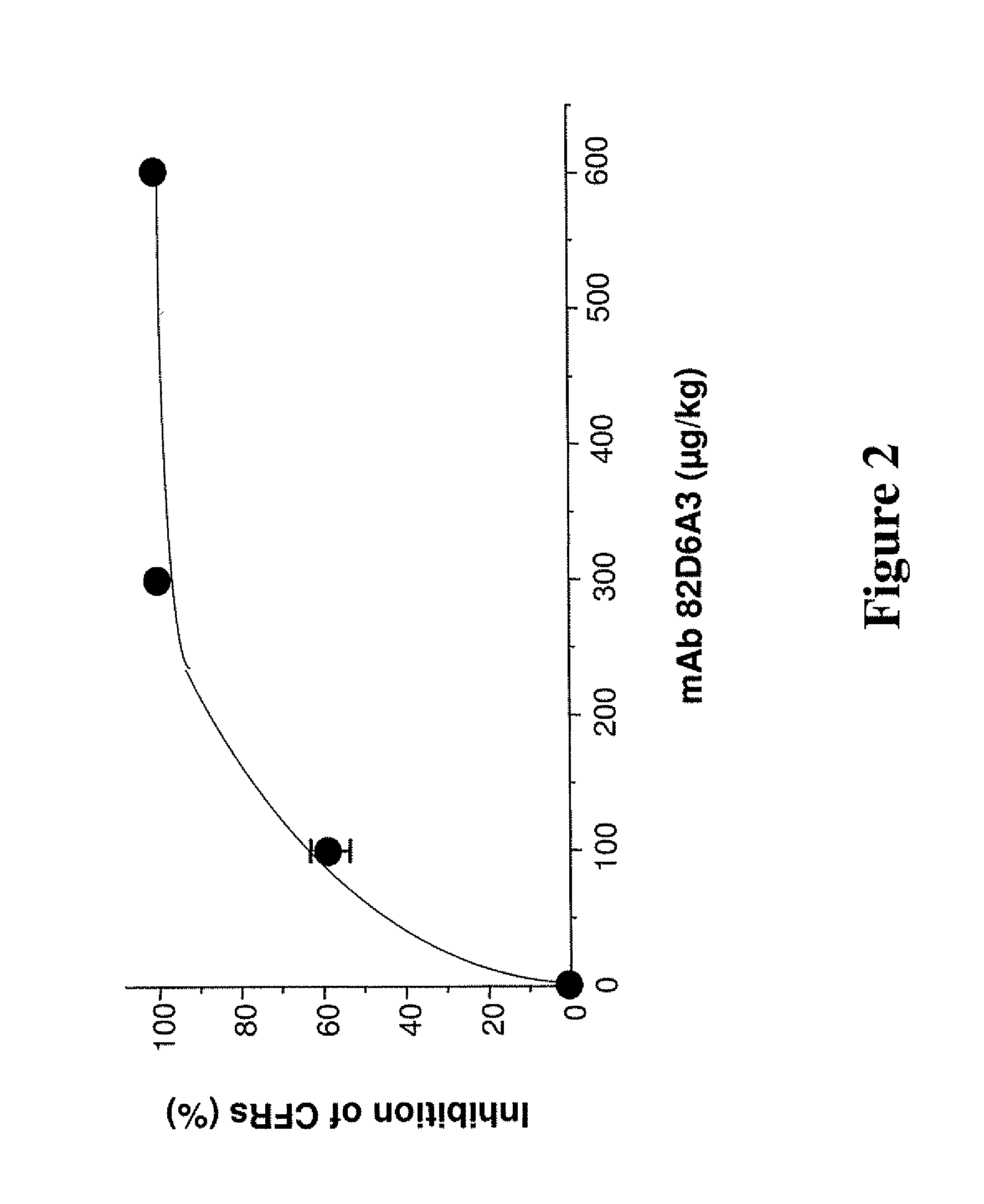[0009]The ligands used as medicaments in the context of the present invention optionally have one or more, preferably all of the features described hereafter. The ligand does not induce severe decline of circulating vWF-levels or a severe decline in platelet count when administered to a primate by bolus intravenous administration at a dose up to 600 μg / kg; the ligand does not result in severe prolongation of bleeding time or does not induce thrombocytopenia when administered to a primate by bolus intravenous administration at a dose up to 600 μg / kg; the ligand occupies vWF and inhibits vWF-collagen binding when administered at a therapeutically effective dose up to 600 μg / kg to a primate by bolus intravenous administration; the ligand does not induce severe decline of circulating vWF-levels; the ligand does not drastically affect clotting time (Prothrombin Time (PT) or activated Partial Thromboplastin Time (aPTT)); the ligand, by interfering with the vWF-collagen interaction, inhibits platelet tethering to a blood vessel surface under high shear stress or at high shear rates.
[0011]Thus the ligands of the present invention are presented to be useful in an antithrombotic treatment to prevent the formation of thrombus, which can be either a non-occlusive thrombus or an occlusive thrombus. Particularly, the antithrombotic treatment is envisaged to prevent arterial thrombus formation, such as acute coronary occlusion. The ligands of the invention are further provided in a method of antithrombotic treatment to maintain the patency of diseased arteries, to prevent restenosis, such as after PCTA or stenting, to prevent thrombus formation in stenosed arteries, to prevent hyperplasia after angioplasty, atherectomy or arterial stenting, to prevent unstable angina, and generally to prevent or treat the occlusive syndrome in a vascular system.
[0014]According to particular embodiments, the present invention thus provides antithrombotic agents which bind with the A3 domain of von Willebrand factor or an epitope thereof, resulting in the inhibition of interaction of von Willebrand factor with collagen, but which is characterized by one or more of the following advantages: administration to an individual does not induce severe bleeding disorders at a minimal medicinal effective dose to exhibit antithrombotic action, does not induce severe decline of circulating vWF-levels or a severe decline in platelet count at a minimal medicinal effective dose to exhibit antithrombotic action, does not result in severe prolongation of bleeding time or does not induce thrombocytopenia at a minimal medicinal effective dose to exhibit antithrombotic action, and / or does not drastically affect clotting time (Prothrombin Time (PT) or activated Partial Thromboplastin Time (aPTT)) at a minimal medicinal effective dose to exhibit antithrombotic action. The invention provides methods of antithrombotic therapy in an individual, comprising administering to the individual at risk of thrombosis, a therapeutically effective amount of the antithrombotic agents of the present invention which inhibits the binding of von Willebrand factor to collagen of a damage blood vessel wall and thereby inhibits platelet tethering to a damaged blood vessel surface.
[0053]The present study evaluated for the first time the antithrombotic effects of inhibiting the vWF-collagen interaction in vivo. For this purpose, we used a monoclonal anti-human vWF antibody mAb 82D6A3 that by binding to the vWF A3-domain inhibits vWF binding to fibrillar collagens type I and III. mAb 82D6A3 furthermore crossreacts with baboon vWF and inhibits baboon vWF binding to collagen type I under static and flow conditions (Depraetere et al., submitted). A modified Folts' model was used to evaluate the antithrombotic efficacy of mAb 82D6A3 under high shear conditions (25) in baboons. This model allows to study the cyclic flow reductions (CFRs) due to platelet-dependent thrombi forming at the injured, stenotic site of the artery. This cyclic flow model has been described as representing some of the events occurring in patients with unstable angina and useful for studying the mechanisms of unstable angina. This model also allows a reproducible pattern of recurrent thrombosis to be established and is widely accepted as very effective and clinically relevant in testing potential antithrombotic agents (27; 28).
[0057]The present invention shows that inhibition of thrombus formation under high shear stress in vivo can not only be obtained by inhibiting the vWF-GPIb interaction but also by interfering with the vWF-collagen interaction. Although also a number of anti-platelet GPIb compounds were successfully used without effect on platelet counts, the risk of inducing thrombocytopenia in some occasions can never be ruled out, as seen with GPIIb-IIIa blockers. A vWF-blocker obviously may be safer in this respect. Both kinds of antithrombotics have the advantage of blocking the first step in thrombus formation which might in addition have some beneficial action in preventing restenosis after PTCA or stenting, in contrast with specific GPIIb-IIIa blockers which only interfere after the platelets have been activated. Activated platelets do not only secrete platelet activating substances but also vasoactive compounds such as platelet derived growth factor, known to induce smooth muscle cell migration and proliferation resulting in restenosis.
 Login to View More
Login to View More 


